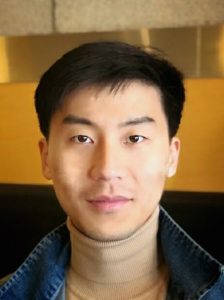 On Monday, October 09 2023, we have the pleasure to welcome in SPINTEC Dongwook GO, Research Scientist at Peter Grünberg Institute and Institute for Advanced Simulation, Forschungszentrum Jülich, Germany.
On Monday, October 09 2023, we have the pleasure to welcome in SPINTEC Dongwook GO, Research Scientist at Peter Grünberg Institute and Institute for Advanced Simulation, Forschungszentrum Jülich, Germany.
He will give us a seminar at 14:00, entitled:
Spin-Orbitronics 2.0: Spintronics Meets Orbitronics
Place: SPINTEC, CEA Building 10.05, auditorium 445 (access needs authorization *)
Zoom link : https://univ-grenoble-alpes-fr.zoom.us/j/94346696587?pwd=M3B0K2tNN2NNSlhlSHIvZ2ZBaHc3Zz09
Passcode: 912746
Abstract : The electron inside a material possesses the orbital degree of freedom originating from the valence orbitals of constituent atoms, which does not exist for the electron in vacuum. However, it has been assumed that the orbital degree of freedom is “frozen” such that it cannot be easily manipulated. Nonetheless, theories predicted the existence of the flow of electrons with finite orbital angular momentum (OAM) [1], which seem to contradict the quenching of the OAM in the ground state. Despite the widespread skepticism, we showed that the orbital quenching does not necessarily prevent the dynamics and transport of OAM, which are in principle non-equilibrium phenomena, because orbitally quenched states can hybridize among each other by external perturbations [2]. The orbital currents were unambiguously confirmed by a recent magneto-optical detection experiment [3], which opens plethora of possibilities of utilizing these new currents [4]. One of the important manifestations of orbital currents can be found in spintronics because the angular momentum can be carried by both spin and orbital degrees of freedom. For example, injection of OAM into a magnet can induce magnetic excitations [5]. So-called “orbital torque” has not only been measured from various experimental groups [6]. It turned out that many phenomena which were assumed to be due to spin currents are in fact due to orbital currents. For example, it was found that orbital currents can cause a magnetoresistance [7]. Also, the interconversion between charge and spin currents is in fact mediated by orbital currents, and harnessing the orbital-to-spin conversion can substantially enhance the efficiency of current-control of magnetization.
In this presentation, I share the vision of orbitronics and how it can significantly reshape the landscape of spintronics research. I propose the initiative “spin-orbitronics 2.0” that aims to fully harness the potential of all charge, spin, and orbital currents and their interconversions. In the first part, I will provide an overview of the state-of-the-art of theoretical and experimental progress made so far and discuss future challenges and big questions to be answered, such as how fast orbital currents are [9], how far they propagate [10], and what their reciprocal processes are like [11]. The second part of the presentation is aimed for experts. I will delve into theories for the description of spin-orbital coupled electrons in magnetic nanostructures and explain both formalisms and first-principles methods, which we have developed in the past years. I will also discuss potential collaboration with working groups in Spintec.
[1] B. A. Bernevig et al. PRL 95, 066601 (2005); H. Kontani et al. PRL 102, 016601 (2009)
[2] D. Go, H.-W. Lee et al. PRL 121, 086602 (2018).
[3] Y. G. Choi, D. Go, H.-W. Lee, G.-M. Choi et al. Nature 619, 52 (2023).
[4] D. Go et al. EPL 135, 37001 (2021); D. Das, Nature Physics 19, 1085 (2023); T. G. Rappoport, Nature 619, 38 (2023).
[5] D. Go and H.-W. Lee, PR Research 2, 013177 (2020).
[6] D. Lee, D. Go, K.-J. Lee et al. NatCommun 12, 6710 (2021); J. Kim. D. Go, Y. Otani et al. PRB 103, L020407 (2021); H. Hayashi, D. Go. K. Ando et al. CommunPhys 6, 32 (2023); G. Sala, P. Gambardella, PR Research 4, 033037 (2022); R. Fukunaga, K. Ando et al. PR Research 5, 023054 (2023).
[7] S. Ding, D. Go, M. Kläui et al. PRL 128, 067201 (2022); S. Ding, P. Gambardella et al. PR Research 4, L032401 (2022).
[8] S. Ding, D. Go, M. Kläui et al. PRL 125, 177201 (2020); S. Lee, D. Go, B.-G. Park et al. CommunPhys 4, 234 (2021)
[9] T. S. Seifert, D. Go, T. Kampfrath et al. Nature Nanotechnology (2023); Y. Xu, A. Fert, W. Zhao et al. arXiv:2208.01866.
[10] D. Go et al. PRL 130, 246701 (2023).
[11] A. E. Hamdi, M. Viret et al. Nature Physics (2023); H. Hayashi, K. Ando, arXiv:2304.05266.
(*) Persons who do not have a CEA pass must request an entry authorization sufficiently in advance, before October 03, 2023 at admin.spintec@cea.fr




